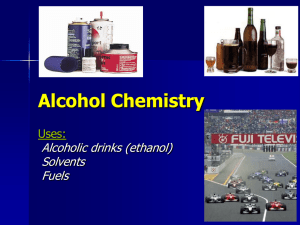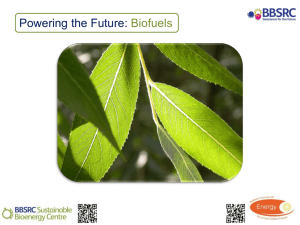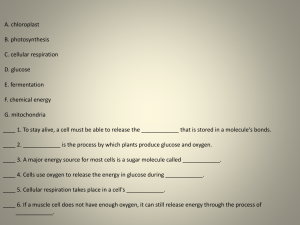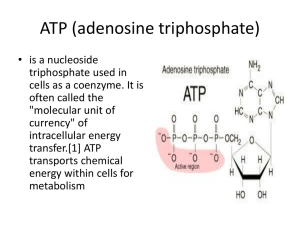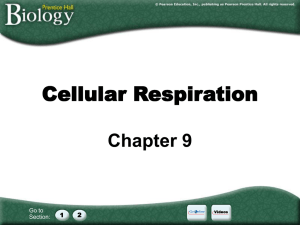Abstract
advertisement
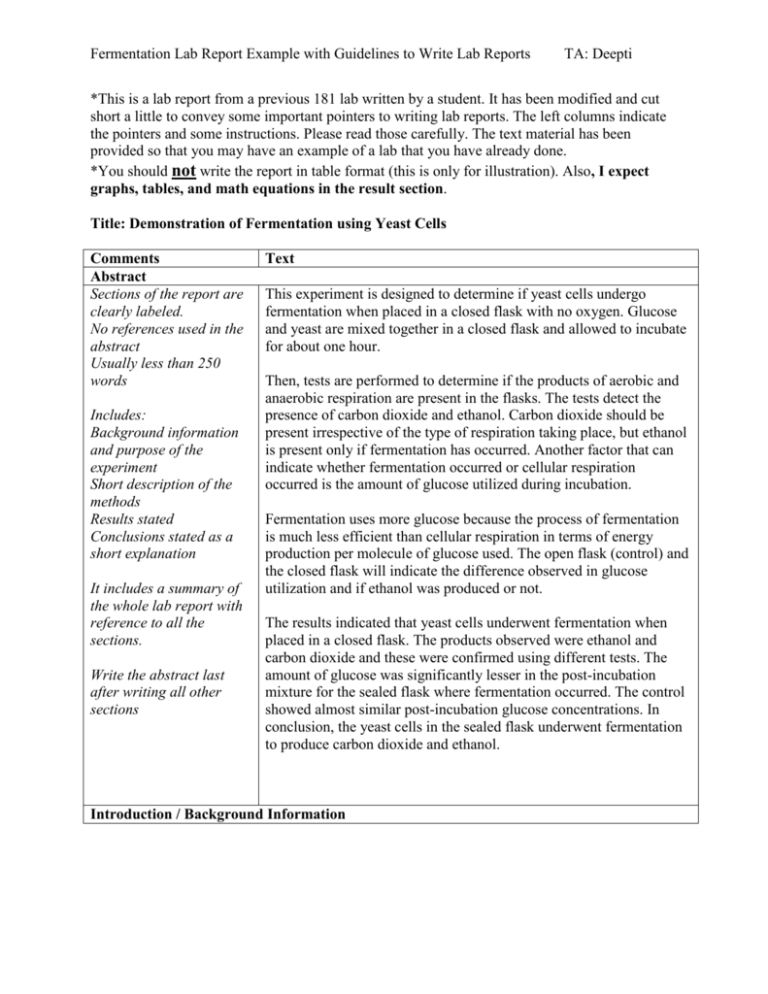
Fermentation Lab Report Example with Guidelines to Write Lab Reports TA: Deepti *This is a lab report from a previous 181 lab written by a student. It has been modified and cut short a little to convey some important pointers to writing lab reports. The left columns indicate the pointers and some instructions. Please read those carefully. The text material has been provided so that you may have an example of a lab that you have already done. *You should not write the report in table format (this is only for illustration). Also, I expect graphs, tables, and math equations in the result section. Title: Demonstration of Fermentation using Yeast Cells Comments Abstract Sections of the report are clearly labeled. No references used in the abstract Usually less than 250 words Includes: Background information and purpose of the experiment Short description of the methods Results stated Conclusions stated as a short explanation It includes a summary of the whole lab report with reference to all the sections. Write the abstract last after writing all other sections Text This experiment is designed to determine if yeast cells undergo fermentation when placed in a closed flask with no oxygen. Glucose and yeast are mixed together in a closed flask and allowed to incubate for about one hour. Then, tests are performed to determine if the products of aerobic and anaerobic respiration are present in the flasks. The tests detect the presence of carbon dioxide and ethanol. Carbon dioxide should be present irrespective of the type of respiration taking place, but ethanol is present only if fermentation has occurred. Another factor that can indicate whether fermentation occurred or cellular respiration occurred is the amount of glucose utilized during incubation. Fermentation uses more glucose because the process of fermentation is much less efficient than cellular respiration in terms of energy production per molecule of glucose used. The open flask (control) and the closed flask will indicate the difference observed in glucose utilization and if ethanol was produced or not. The results indicated that yeast cells underwent fermentation when placed in a closed flask. The products observed were ethanol and carbon dioxide and these were confirmed using different tests. The amount of glucose was significantly lesser in the post-incubation mixture for the sealed flask where fermentation occurred. The control showed almost similar post-incubation glucose concentrations. In conclusion, the yeast cells in the sealed flask underwent fermentation to produce carbon dioxide and ethanol. Introduction / Background Information Fermentation Lab Report Example with Guidelines to Write Lab Reports Background Information Hypothesis stated Proper citations used Cited material paraphrased and cited appropriately Purpose of the experiment stated TA: Deepti The processes of aerobic respiration and fermentation both begin with glycolysis. The difference between the two is that respiration occurs in the presence of oxygen and fermentation occurs in the absence of oxygen (anaerobic respiration). Fermentation is a quick but very inefficient method of producing energy for the cells. As a result, in the absence of oxygen, the cell must use more glucose in order to generate the same amount of energy. The differences in ATP production between fermentation and cellular respiration can be seen in the equations below. Facultative anaerobes usually respire through aerobic respiration, but have the ability to undergo fermentation if the environment becomes oxygen deficient. Yeast cells are facultative anaerobes that produce ethanol when they engage in fermentation. (Grimes et al. 2002) In the presence of oxygen, cells undergo aerobic cellular respiration. It uses glucose in the presence of oxygen to produce CO2, H2O and ATP. C6H12O6 + 6 O2 6 CO2 + 6 H2O + 36 ATP In an anaerobic environment, the yeast cells undergo fermentation. In fermentation, glucose enters glycolysis and produces reduced NADH +H+ and pyruvate molecules. In the next part pyruvate is converted to acetaldehyde and then to ethanol. This step oxidizes the NADH back to NAD+ so that it may be regenerated and reused in the glycolysis. This enables the fermentation cycle to continue. (Grimes et al. 2002) The equation for fermentation is C6H12O6 2 CH3CH2OH + 2 CO2 + 2 ATP This equation represents a type of fermentation where ethanol is produced. The other type of fermentation, which occurs in muscle cells and certain bacteria, produces lactic acid only. Yeast cells undergo only alcohol fermentation. (Grimes et al, 2002) The purpose of this experiment was to determine if yeast cells underwent fermentation in a closed flask and utilized glucose as a substrate to produce ethanol and carbon dioxide. The products of both aerobic and anaerobic fermentation are known and the products in the flask will be tested after incubation for approximately 1 hour. An open flask will be used as a control to obtain data for glucose utilization in aerobic conditions. In the control (open flask) we will measure the pre and post-incubation glucose concentration and test for ethanol. In the test flasks, the initial and final glucose concentrations will be measured and also tests will be conducted to confirm the presence of carbon dioxide and ethanol. The hypothesis is that yeast cells will undergo fermentation in the absence of oxygen in the air in a sealed flask. Fermentation will occur Fermentation Lab Report Example with Guidelines to Write Lab Reports TA: Deepti after the yeast cells utilize the limited amount of oxygen in the sealed flask. In the control flask (open flask) the yeast cells will undergo cellular respiration and will not undergo fermentation, since oxygen is present. Both the closed and open flasks should produce carbon dioxide, but the amount of carbon dioxide will only be measured in the closed flasks (because the flask must be closed to measure carbon dioxide, so the open flasks cannot be tested for carbon dioxide). The difference between the initial and final glucose concentrations is expected to be greater in the closed flask, since fermentation uses more glucose to meet the energy requirements of the yeast cells. Materials and Methods Sufficient detail provided for reader to be able to perform the experiment in exactly the same way. Please refer to the lab manual pages 30-33 in the lab manual (Grimes et al, 2002) Deviation: 100 fold dilution was used to measure glucose concentration Figures to explain methodology may be included. For the purpose of this lab you may write…Refer to lab manual pages…with a reference. But please make sure that you include deviations from the lab manual in your experiment. Results Data presented Figures and graphs to best represent the information Include appropriate titles and labels. Describe in words a short summary of the data and results observed. Table 1: Equations Aerobic Respiration Fermentation CO2 Test Chromic Anhydride Test C6H12O6 + 6 O2 6 CO2 + 6 H2O + 36 ATP C6H12O6 2 CH3CH2OH + 2 CO2 + 2 ATP CO2 + H2O H2CO3 H2CO3 + Ba(OH)2 BaCO3 (ppt) + H2O CH3CH2-OH (ethanol) + CrO3 (red) CH3HC=O + Cr3+ (green) +H2O Fermentation Lab Report Example with Guidelines to Write Lab Reports TA: Deepti Do not interpret or explain the results here. Table 2: Data Summary Initial Glucose conc. Final Glucose conc. Closed Flask 500 mg/ ml 250 mg/ ml Open Flask 500 mg/ml ~ 500 mg/ml CO2 test using barium hydroxide Positive Ethanol test using chromic anhydride Positive Not done Negative Ethanol combustion test Positive (burned with a pale blue flame) Negative This table shows that there was no evidence of production of ethanol in the open control flask. The closed test flask results indicate that ethanol and carbon dioxide were produced. The final glucose concentration in the closed flask decreased significantly but that in the open flask almost remained the same as the initial concentration. Calculations for the Pre and Post Incubation Glucose Concentrations The diastix reading showed the concentration in mg/ dL in a 100 fold diluted solution. Closed flask Accounting for the 100-fold dilution: 500 mg/dL x 100 = 50000 mg/dL in the original solution. Converting from mg/ dL to mg/ ml (100ml=1dL) 50000/ 100 = 500 mg/ml Initial glucose concentration = 500 mg/ ml Final glucose concentration = 300 mg/ ml Amount of glucose used by the yeast cells during the incubation period = 500-300 = 200 mg/ ml Discussion Restate the significant results These data indicate that the yeast cells in the closed flasks produced ethanol and carbon dioxide. The open flask did not produce any ethanol after incubation. The hypothesis that yeast cells undergo Fermentation Lab Report Example with Guidelines to Write Lab Reports Restate the hypothesis and state whether it was supported/ partially supported/ partially refuted/ refuted (Do not say that hypothesis was “proven right or wrong”) Explanation and interpretation of the results provided here Potential or actual errors that occurred in the experiment. Additional ways to test explanations can be mentioned. Mention the limitations of your experiment. Ideas for future experimentation. TA: Deepti fermentation in the absence of oxygen to produce carbon dioxide and ethanol was supported by this experiment. The rate of glucose utilization during fermentation was much faster in the closed flask. The amount of glucose utilized in the closed flask was 200mg/ml. The post incubation glucose concentration was almost unchanged in the open flask. Both the initial and final glucose concentrations in the open flask were almost 500 mg/ml and showed no significant measurable difference. This indicates that the process of fermentation is much less effective than cellular respiration for provision of the energy requirements of the yeast cells. This makes the yeast cells use the glucose much faster in the absence of oxygen. The closed flask yeast cells probably underwent aerobic respiration for a very short while in the beginning till the oxygen in the closed flask was finished. After that it switched to fermentation. Some potential errors in the experiment may be due to the diastix strips used to estimate the glucose concentrations, which are not very sensitive to smaller changes in the glucose concentrations. The colors are not an objective method to determine concentrations and can be subject to individual reading errors. You may use references to explain your results and support explanations. Future experiments may be conducted with glucose measurements more frequently during the incubation periods. That may provide a rate of glucose utilization. Testing different temperatures and their effects on the rate of fermentation will be interesting. Also apparatus to collect the carbon dioxide produced during cellular respiration will be useful. Better glucose estimation methods required for providing more accurate results. References Use any specific format to cite references but make sure to use it consistently. Grimes, W., Hallick R., Hewlett M., Aronson J., Fishel B. 2002 Biology 181 Laboratory Manual. Hayden-McNeil Publishing, Inc. Plymouth, Michigan. Pages 25-34. The citations within the text material of your lab report must be referenced here appropriately. Use only authentic reference sources and be wary of internet sites. For reference citations: http://dizzy.library.arizona.edu/library/type1/tips/data/citation.html Fermentation Lab Report Example with Guidelines to Write Lab Reports TA: Deepti References Karin Knisely. A Student Handbook for Writing in Biology. 2002. Sinauer Associates, Inc. Anonymous. Previous 181 lab student.


